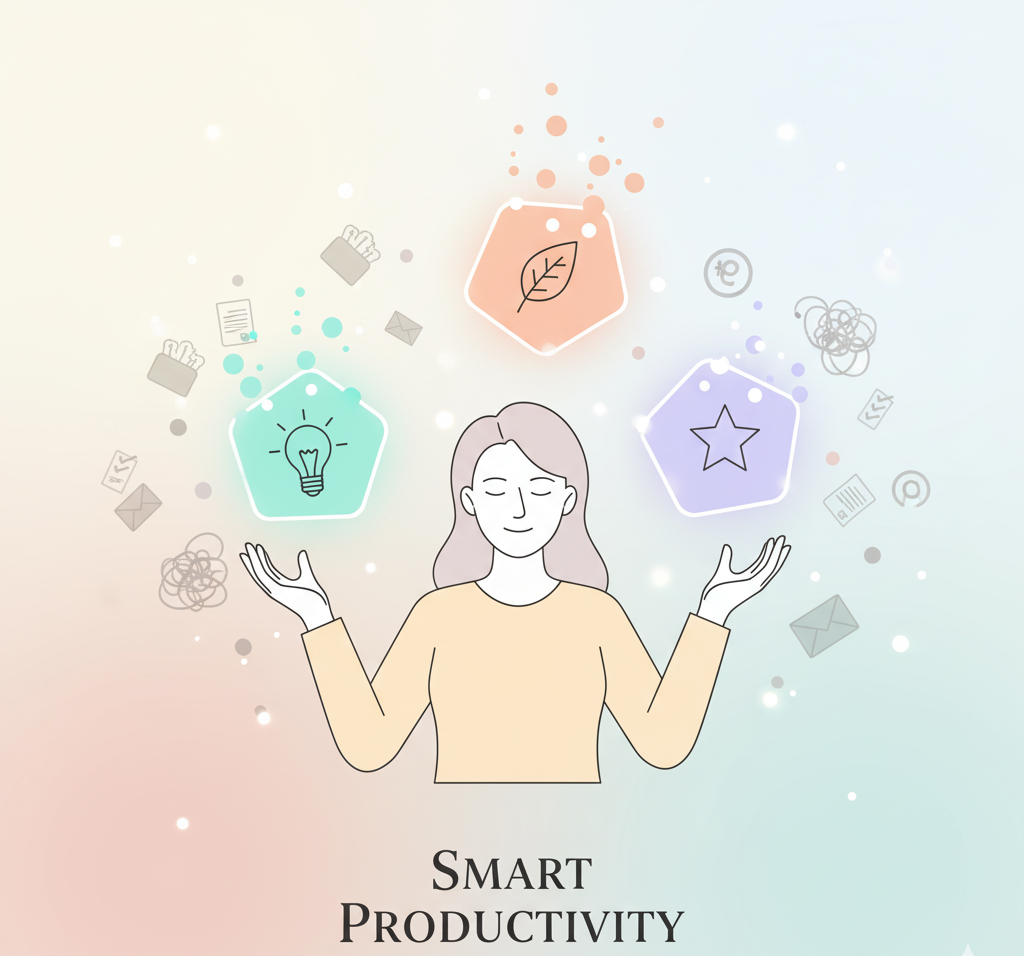Let’s be honest — we’ve all been there. You’re racing through tasks, juggling endless tabs, and convincing yourself that “busy” equals “productive.” But by the end of the day, you’re drained, your to-do list looks suspiciously longer, and you can’t remember what actually got done. Sound familiar?
I used to believe that working harder was the answer. That if I just pushed a little more, stayed up a little later, or powered through another cup of coffee, I’d finally catch up. Spoiler: I never did. What finally changed everything wasn’t more effort — it was learning the art of doing less.
In this post, we’ll explore what it really means to work smarter, not harder. You’ll learn practical ways to simplify your workflow, reclaim your focus, and make your energy count.
Rethinking Productivity: Why “Doing More” Doesn’t Always Mean Progress
We’ve been taught to glorify being busy. Long hours. Multitasking. Hustle culture. But here’s the truth — productivity isn’t about how much you do, it’s about what actually moves you forward.
Think about it: how many times have you spent hours answering emails, attending meetings, or “preparing” to start, only to feel like nothing meaningful got done? That’s the trap of false productivity — activity that feels productive but achieves little.
The Problem With the “Always-On” Mindset
When you’re constantly in motion, your brain never fully resets. You’re running on mental autopilot — reacting instead of creating. That’s when burnout creeps in.
Key takeaway: Real productivity starts when you stop confusing busyness with progress.
To work smarter, you have to get strategic about your attention — not just your time.
Step 1: Clarify What Actually Matters
Working smarter starts with intentional clarity. If you don’t know where your effort should go, you’ll end up spreading it thin across everything.
Ask yourself:
- What are my top three priorities this week?
- Which tasks actually create progress toward my bigger goals?
- What could I stop doing without major consequences?
The Eisenhower Matrix: A Simple Tool for Clarity
One of the simplest frameworks for working smarter is the Eisenhower Matrix, which helps you prioritize by urgency and importance:
- Important + Urgent: Do it now.
- Important + Not Urgent: Schedule it.
- Not Important + Urgent: Delegate it.
- Not Important + Not Urgent: Delete it.
This matrix helps you identify what truly deserves your energy — and what’s just noise.
Once I started categorizing tasks this way, I realized half of what I was “too busy” doing didn’t actually matter. It was freeing — like cleaning mental clutter.
Key takeaway: Clarity is power. You can’t work smarter if you’re not sure what matters most.
Step 2: Simplify Your Workflow

Even with the right priorities, cluttered systems can keep you stuck. Working smarter means streamlining how you work — not adding more apps or routines.
Start With These Three Shifts:
- Batch similar tasks.
Grouping tasks that require similar energy (like writing, calls, or admin) helps your brain stay focused. - Set boundaries around deep work.
Block 90-minute sessions for focused, distraction-free work. No email, no Slack, no phone notifications. - Create a daily shutdown ritual.
End each day by reviewing what worked, what didn’t, and what’s next. It clears your mental space and signals your brain to rest.
Pro tip: I use Notion to organize my daily workflow — it’s flexible, visual, and helps me track only what matters.
Key takeaway: Simplify your process. A clean system is a productive system.
Step 3: Protect Your Energy, Not Just Your Time

We often think time is the main bottleneck, but it’s actually energy. You can have a perfectly planned day and still crash halfway through if your energy isn’t managed.
Ways to Protect Your Energy:
- Start slow. A calm morning routine sets the tone for focus.
- Move often. Short walks or stretching breaks reset your mental clarity.
- Schedule creative work when you’re sharpest. Morning person? Write early. Night owl? Batch admin tasks for later.
Remember, working smarter means designing your schedule around your natural energy — not forcing productivity at random times.
I used to power through afternoons with coffee and sheer willpower. But shifting creative work to mornings (and admin to afternoons) doubled my output — with half the stress.
Key takeaway: Energy management is smarter than time management.
Step 4: Embrace the Power of “No”

If you say yes to everything, you’re saying no to what truly matters. Learning to decline gracefully is one of the most underrated productivity skills.
How to Say “No” Without the Guilt:
- Buy time. “Let me check my schedule and get back to you.”
- Offer alternatives. “I can’t commit now, but I know someone who might help.”
- Be honest, not apologetic. “I don’t have the capacity for this right now.”
Saying no creates space for your best work to emerge — and for your mind to rest.
The first time I declined a “great opportunity,” I was terrified. But the relief that followed? Instant. The freedom to focus on what mattered most was worth it.
Key takeaway: Saying no isn’t selfish — it’s strategic clarity.
Step 5: Redefine Success
We live in a culture that celebrates output, not intention. But doing less doesn’t mean doing nothing — it means doing the right things, well.
Try this thought experiment:
If you could achieve your biggest goals by working fewer, smarter hours — would you take it?
Success today isn’t measured by exhaustion, but by alignment — how well your actions reflect your values and priorities.
I’ve had weeks where I worked half as much and achieved more. The difference? Focus and intention.
Key takeaway: Redefine success as sustainable progress, not constant hustle.
Conclusion: Doing Less, But Better

Working smarter isn’t about shortcuts — it’s about intentional focus. When you clarify what matters, simplify your systems, and protect your energy, you start achieving more by doing less.
Start small. Say no once this week. Batch your tasks. Protect one deep work session.
You’ll be amazed at how much calmer — and more productive — your days feel.
And if you’re ready to take this mindset further, check out “The Best Monthly Review System for You” — it’s the perfect next step to refine your focus and build a system that sticks.





